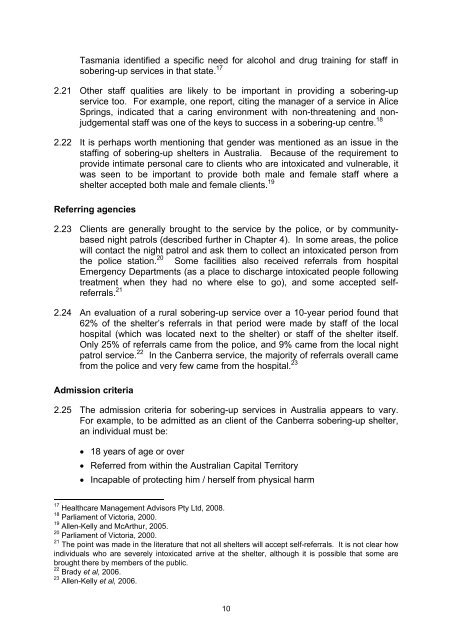Services that Manage the Care Needs of Drunk - Scottish Government
Services that Manage the Care Needs of Drunk - Scottish Government
Services that Manage the Care Needs of Drunk - Scottish Government
You also want an ePaper? Increase the reach of your titles
YUMPU automatically turns print PDFs into web optimized ePapers that Google loves.
Tasmania identified a specific need for alcohol and drug training for staff in<br />
sobering-up services in <strong>that</strong> state. 17<br />
2.21 O<strong>the</strong>r staff qualities are likely to be important in providing a sobering-up<br />
service too. For example, one report, citing <strong>the</strong> manager <strong>of</strong> a service in Alice<br />
Springs, indicated <strong>that</strong> a caring environment with non-threatening and nonjudgemental<br />
staff was one <strong>of</strong> <strong>the</strong> keys to success in a sobering-up centre. 18<br />
2.22 It is perhaps worth mentioning <strong>that</strong> gender was mentioned as an issue in <strong>the</strong><br />
staffing <strong>of</strong> sobering-up shelters in Australia. Because <strong>of</strong> <strong>the</strong> requirement to<br />
provide intimate personal care to clients who are intoxicated and vulnerable, it<br />
was seen to be important to provide both male and female staff where a<br />
shelter accepted both male and female clients. 19<br />
Referring agencies<br />
2.23 Clients are generally brought to <strong>the</strong> service by <strong>the</strong> police, or by communitybased<br />
night patrols (described fur<strong>the</strong>r in Chapter 4). In some areas, <strong>the</strong> police<br />
will contact <strong>the</strong> night patrol and ask <strong>the</strong>m to collect an intoxicated person from<br />
<strong>the</strong> police station. 20 Some facilities also received referrals from hospital<br />
Emergency Departments (as a place to discharge intoxicated people following<br />
treatment when <strong>the</strong>y had no where else to go), and some accepted selfreferrals.<br />
21<br />
2.24 An evaluation <strong>of</strong> a rural sobering-up service over a 10-year period found <strong>that</strong><br />
62% <strong>of</strong> <strong>the</strong> shelter’s referrals in <strong>that</strong> period were made by staff <strong>of</strong> <strong>the</strong> local<br />
hospital (which was located next to <strong>the</strong> shelter) or staff <strong>of</strong> <strong>the</strong> shelter itself.<br />
Only 25% <strong>of</strong> referrals came from <strong>the</strong> police, and 9% came from <strong>the</strong> local night<br />
patrol service. 22 In <strong>the</strong> Canberra service, <strong>the</strong> majority <strong>of</strong> referrals overall came<br />
from <strong>the</strong> police and very few came from <strong>the</strong> hospital. 23<br />
Admission criteria<br />
2.25 The admission criteria for sobering-up services in Australia appears to vary.<br />
For example, to be admitted as an client <strong>of</strong> <strong>the</strong> Canberra sobering-up shelter,<br />
an individual must be:<br />
• 18 years <strong>of</strong> age or over<br />
• Referred from within <strong>the</strong> Australian Capital Territory<br />
• Incapable <strong>of</strong> protecting him / herself from physical harm<br />
17<br />
Healthcare <strong>Manage</strong>ment Advisors Pty Ltd, 2008.<br />
18<br />
Parliament <strong>of</strong> Victoria, 2000.<br />
19<br />
Allen-Kelly and McArthur, 2005.<br />
20<br />
Parliament <strong>of</strong> Victoria, 2000.<br />
21<br />
The point was made in <strong>the</strong> literature <strong>that</strong> not all shelters will accept self-referrals. It is not clear how<br />
individuals who are severely intoxicated arrive at <strong>the</strong> shelter, although it is possible <strong>that</strong> some are<br />
brought <strong>the</strong>re by members <strong>of</strong> <strong>the</strong> public.<br />
22<br />
Brady et al, 2006.<br />
23<br />
Allen-Kelly et al, 2006.<br />
10

















